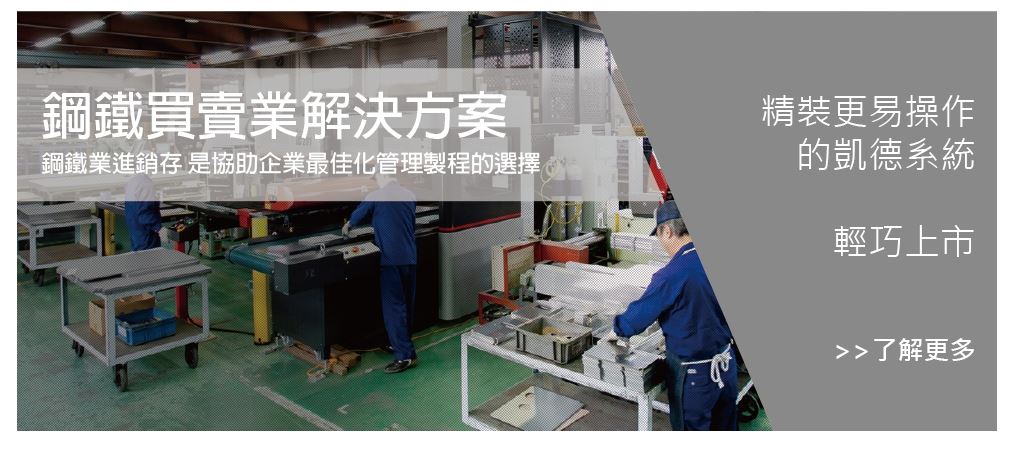- PRODUCTS商品櫥窗
商品明細
商品詳細介紹Product Introduction
鋼鐵業進銷存(Steel Industry)
指對原材料、半成品和成品的進、銷售以及庫存進行有效控制和管理的過程。進銷存管理對於鋼鐵業來說非常重要,因為這是一個資本密集型行業,涉及到大量的資金和資源。
以下是一些與鋼鐵業進銷存管理相關的重要考慮因素:
1.供應鏈管理: 確保供應鏈的順暢運作是鋼鐵業成功的重要因素。這包括確保原材料供應的穩定性,減少因供應不穩定性而導致的庫存波動。
2.需求預測: 制定準確的需求預測是進銷存管理。透過市場調查、歷史銷售數據等手段,預測市場需求,以便調整生產和庫存水平。
3.庫存優化: 避免過度庫存和庫存不足是進銷存管理的核心目標之一。透過有效的庫存管理系統,確保在需要時有足夠的存貨,同時盡量減少庫存持有成本。
4.生產計劃: 根據市場需求和庫存水平,制定合理的生產計劃。這涉及到生產量的合理安排,以確保足夠的庫存可供應,同時避免過度生產。
5.物流和運輸: 鋼鐵業的產品通常是重而且體積大的,因此有效的物流和運輸管理至關重要。確保及時交付和降低運輸成本是進銷存管理中的關鍵因素。
6.技術應用: 利用現代技術,例如物聯網(IoT)、大數據分析等,來提高進銷存管理的效率。實時監控庫存、生產和銷售數據,有助於更及時地做出反應性調整。
7.風險管理: 鑑於鋼鐵業常受到原材料價格波動、市場需求不確定等風險的影響,進銷存管理應考慮風險,制定應對策略,以確保業務的穩定運作。
綜合來說,鋼鐵業的進銷存管理需要綜合考慮供應鏈、需求、庫存、生產、物流等多個方面,以實現生產和銷售的最佳平衡,確保企業的長期可持續發展。
Inventory management in the steel industry refers to the effective control and management of the process of procurement, sales, and inventory of raw materials, semi-finished goods, and finished products. It is a critical aspect for the steel industry, given its capital-intensive nature and involvement of significant financial resources.
Here are some key considerations related to inventory management in the steel industry:
1.Supply Chain Management: Ensuring the smooth operation of the supply chain is a crucial factor for the success of the steel industry. This includes ensuring the stability of raw material supply and minimizing inventory fluctuations caused by supply chain instability.
2.Demand Forecasting: Accurate demand forecasting is essential for effective inventory management. Through methods such as market research and analysis of historical sales data, predicting market demand allows for adjustments in production and inventory levels.
3.Inventory Optimization: Avoiding excessive or insufficient inventory is a core objective of inventory management. Utilizing an effective inventory management system ensures sufficient stock when needed while minimizing holding costs.
4.Production Planning: Developing reasonable production plans based on market demand and inventory levels is crucial. This involves a rational arrangement of production quantities to ensure an adequate supply of inventory while avoiding overproduction.
5.Logistics and Transportation: Given the heavyweight and large volume nature of steel products, efficient logistics and transportation management are crucial. Ensuring timely delivery and reducing transportation costs are key factors in inventory management.
6.Technological Applications: Leveraging modern technologies such as the Internet of Things (IoT) and big data analytics can enhance the efficiency of inventory management. Real-time monitoring of inventory, production, and sales data facilitates more timely and responsive adjustments.
7.Risk Management: Considering the impact of risks such as fluctuating raw material prices and uncertain market demand, inventory management should incorporate risk considerations. Developing strategies to address risks ensures the stable operation of the business.
In summary, inventory management in the steel industry requires a comprehensive consideration of factors including supply chain, demand, inventory, production, and logistics to achieve the optimal balance between production and sales, ensuring the long-term sustainability of the enterprise.




